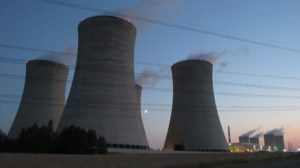Following the magnitude 6.5 earthquake World Energy Council Japan reports no damage was done to the five reactors of the two nuclear power stations in the region, the Sendai and Genkai Nuclear Power Stations, both operated by Kyushu Electric Power Company.
Two reactors at Sendai Nuclear Power Station were shaken by a tremor of an intensity of 4 on the Japanese scale in the early hours of 16 April. The reactors had been operating since they were restarted five and seven months ago, respectively, after a long period of shutdown following the Fukushima nuclear accident. They have remained unscathed after the earthquakes and have continued operation, according to Kyushu Electric.
Genkai Nuclear Power Station, whose three reactors had been offline before the earthquakes, is located 110 kilometers north by northwest of the epicenter of the earthquakes, while Sendai Nuclear Power Station is located 92 kilometers south by southwest of the epicenter.
At a press conference, after an extraordinary meeting of the Nuclear Regulation Authority (NRA), on 18 April, the Head of the NRA said there was no need to shut down the reactors in operation.
Shunichi Tanaka, Chairman of the NRA said:
Asked about calls from some people demanding that the Sendai Nuclear Power Plant’s operations be suspended, Tanaka stated that the NRA has "evaluated the situation in consideration of uncertainty factors as well and has concluded that an unexpected accident is unlikely to occur. For the moment, it is not necessary to suspend the plant's operation."
As a result of the earthquakes, three steel towers supporting 66kV power transmission lines tilted and became deformed. In addition, power distribution poles in urban areas were damaged. As a consequence the electricity supply to 470,000 households was disrupted (as of 2 a.m. 16 April), but power outages were totally resolved by the end of 20 April.
48 people were killed and nearly 200,000 were people evacuated at the peak.
Traffic on the trunk road in Kumamoto Prefecture was cut off and a large bridge fell. While an out of service train derailed on the Shinkansen (high-speed railway), no human casualties were caused.
As many firms in the Kumamoto area producing critical parts were damaged by the quakes, the supply-chain of major manufactures such as Sony and Toyota were paralysed, forcing them to temporarily shut down their assembly factories in other regions.
Electric power companies from other regions across Japan sent power generation vehicles to the disaster area in Kumamoto as well as teams of supporting staff to help restore power facilities. These teams are cooperating with Kyushu Electric in inspecting the facilities and taking other necessary measures. Also of particular note, was the U.S. military’s support transporting relief goods by Osprey aircraft.
Japan has recently launched national resilience studies and organised high-level meetings to identify resilience measures in preparation for unanticipated disruptions in the energy sector, and to keep its citizens safe. The member committee has also expressed its gratitude for all the support received from abroad.






